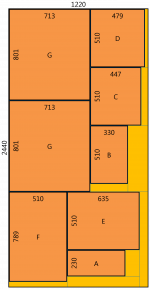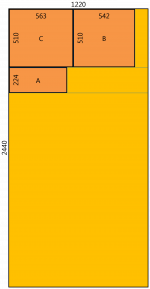Is there no way to get this design to be a carry-able weight (one person) ie 30-34kgs? if I use thinner material and this driver? JDs Sound and Lighting. Ande 15" LB15-1 350W driver / speaker
Small-loud-40Hz and below - pick two
The only way to get a smaller cabinet is to use a smaller driver. Even then, the folding may have to be a bit different. One possibility - look at car audio "SPL" type 10" drivers (50 Hz<Fs<60 Hz, 0.3<Qts<0.4, good Xmax). It should be possible to get a good TH out of them, but you're going to lose 3~6dB of sensitivity in the process. However, you can build multiples of these to get back that efficiency, and each box should be quite portable if done right.
Hi Crescendo,
In the singlesheet thread I suggested a bigger version, about 22"x32"x48", would that be too big for you? It goes roughly 10Hz lower than the SS15.
Regards,
Did you post an image/plan/hr input or just the idea? If you did, approximately what page?
Cluster of four @ x-max, not bad i think.
It is worth to notice the size of this cab, it is actually small, about 30% smaller than TH-18 (Xoc1's design) and TH 115/TH 118 by Danley.
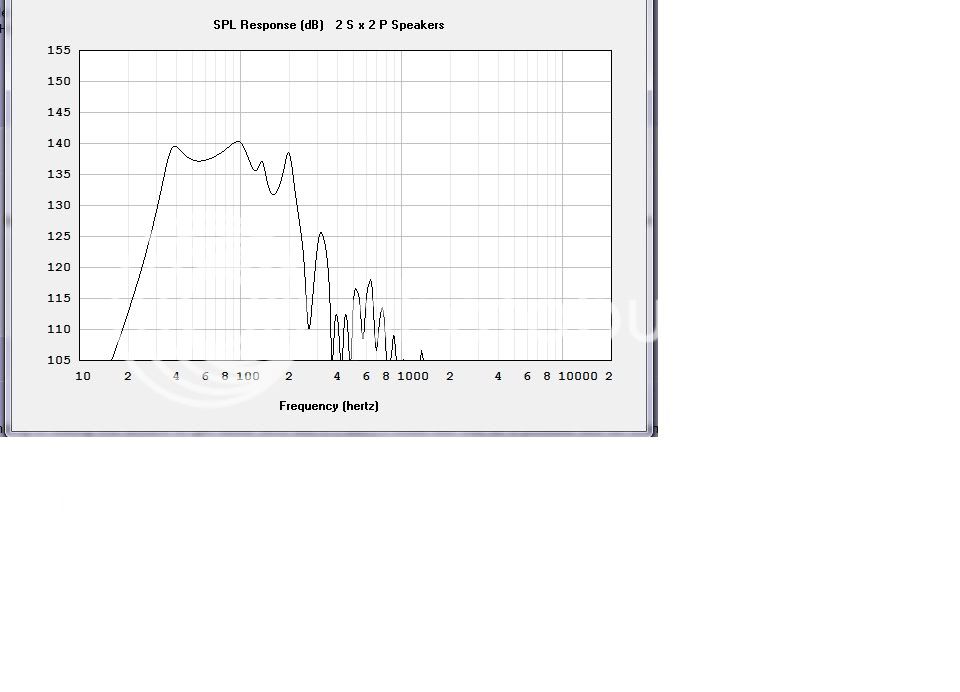
Dag
Is this modelled w/the LABs? I don't get nearly that smooth of a response to 40Hz (and -7 or 8dB @ 35) w/the HR input info you gave in post #9 w/the 3015LF
An externally hosted image should be here but it was not working when we last tested it.
Last edited:
Hi Crescendo, i'll admit this tread is a little confusing.
The 3015LF version is over and out, it sounded good, but the cone came loose from the spider using less than 500 watts even setting the subsonic to 35Hz.
Now it is LAB 15 and it sounds very good, it have all the atributes of a good TH.
Here are my Hornresp inputs, i have meassured my own set of Thiele-Small data after some break in. (its not that different from the manufacturers data)
My goal was to hit 100dB's @ 40Hz, and i think i have done that.
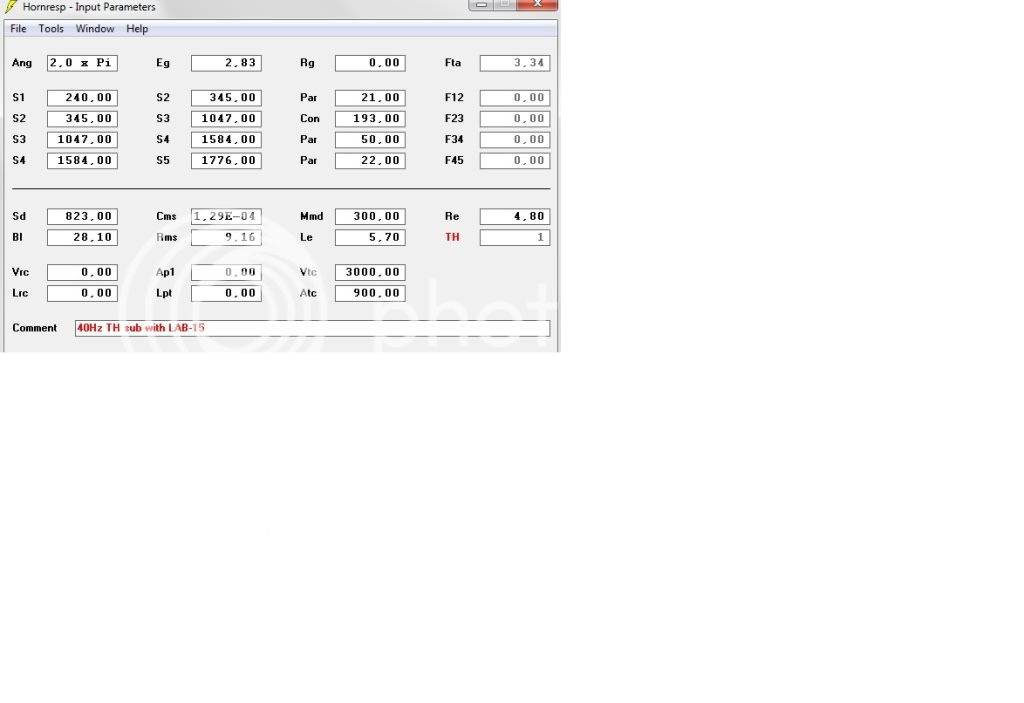
Black trace, 4cabs - grey trace, one.
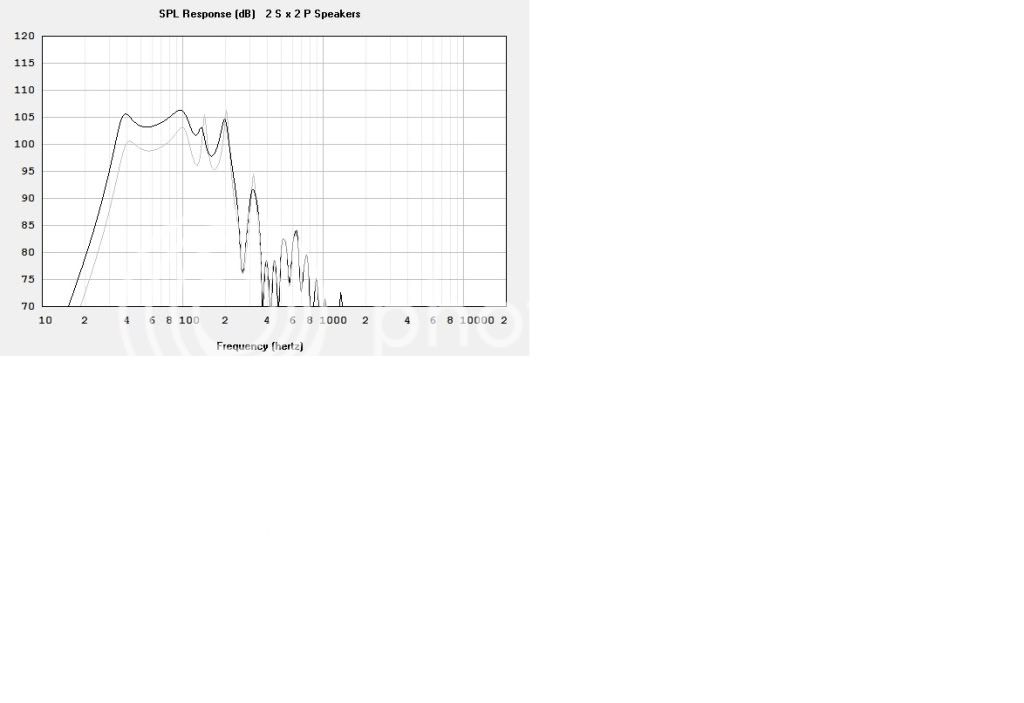
Dag
The 3015LF version is over and out, it sounded good, but the cone came loose from the spider using less than 500 watts even setting the subsonic to 35Hz.
Now it is LAB 15 and it sounds very good, it have all the atributes of a good TH.
Here are my Hornresp inputs, i have meassured my own set of Thiele-Small data after some break in. (its not that different from the manufacturers data)
My goal was to hit 100dB's @ 40Hz, and i think i have done that.

Black trace, 4cabs - grey trace, one.

Dag
That looks great - terrific job!
That's too bad about the 3015LFs; I've got 6... 2 are in jbell's SS15s, 2 are in BFM T48s and 2 are still in the box. But, I'm looking for more <40Hz for the dnb/dubstep shows I do, so the search continues (until more money comes along to buy more amps and build some 18" THs).
Keep up the great work!
That's too bad about the 3015LFs; I've got 6... 2 are in jbell's SS15s, 2 are in BFM T48s and 2 are still in the box. But, I'm looking for more <40Hz for the dnb/dubstep shows I do, so the search continues (until more money comes along to buy more amps and build some 18" THs).
Keep up the great work!
hi justenThat looks great - terrific job!
That's too bad about the 3015LFs; I've got 6... 2 are in jbell's SS15s, 2 are in BFM T48s and 2 are still in the box. But, I'm looking for more <40Hz for the dnb/dubstep shows I do, so the search continues (until more money comes along to buy more amps and build some 18" THs).
Keep up the great work!
a straigt th of 6 or 7' long works wel for the 3015 ,all area's 1000 or 1100cm2.
not verry efficient but with 3 a side ,wil preform good till 30 hz in a 250-300 ltr cab
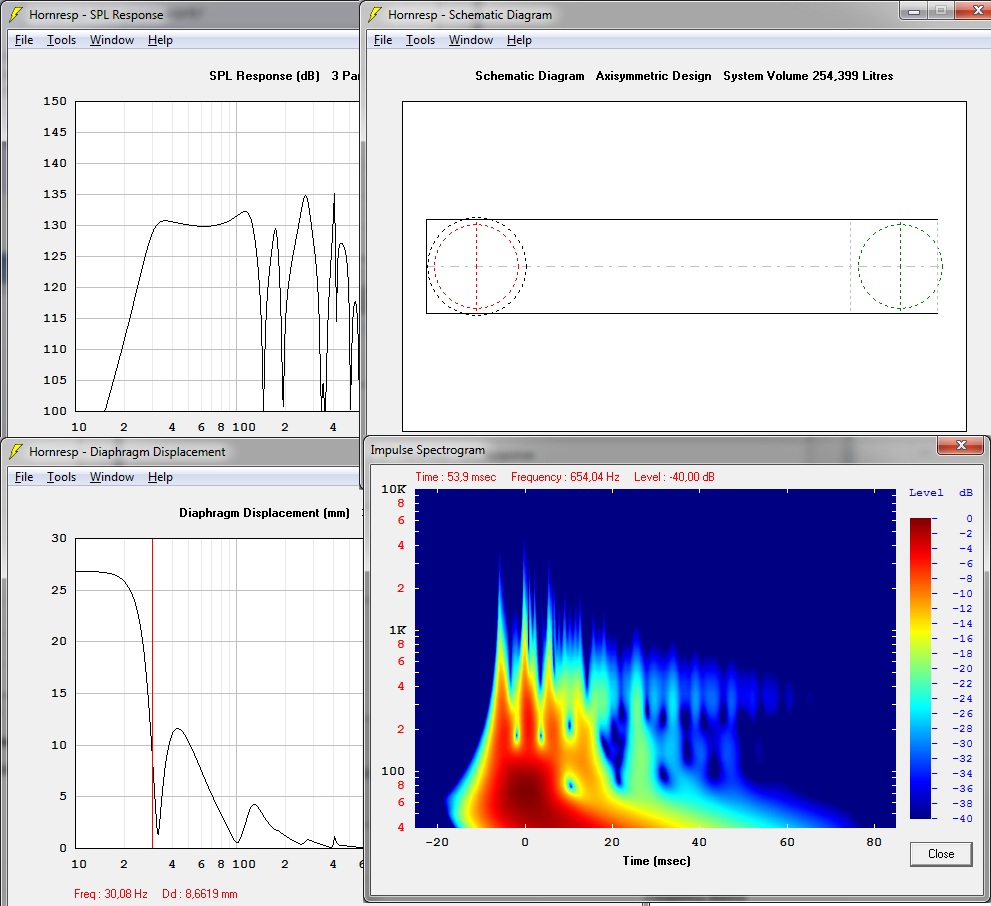
easy to design and bild
Last edited:
Now it is LAB 15 and it sounds very good, it have all the atributes of a good TH.
...
My goal was to hit 100dB's @ 40Hz, and i think i have done that.
Hey Dag,
Do you have any output measurements of your beautiful enclosures? I'd like to find out what they put out in the real world, with compression figures factored in.
Hi all...
No measurements so far, its too cold to take any outside.
Four cabinets are in heavy use, almost every weekend, they work flawlesly and the sound is simply amazing.
I'm going to upgrade on the poweramps, they are getting about 600watts now, they can take more.
@Dunderkeppan: about 2 inches.
Dag
No measurements so far, its too cold to take any outside.
Four cabinets are in heavy use, almost every weekend, they work flawlesly and the sound is simply amazing.
I'm going to upgrade on the poweramps, they are getting about 600watts now, they can take more.
@Dunderkeppan: about 2 inches.
Dag
So the speakerplan for this cab that you previously posted, that´s the one I should follow if I want to build it? There´s no such ''reflectors'' in the corners?
Thinking of actually building it, so I want to be 100 % sure.
Thanks!
Kevin
They are playing now as per plan in this tread.
I'm not convinced about the effect of reflectors/deflectors, but i dont think they will do any damage.
I do recomend a center bracing throughout the pathway, i'm going to innstall this in the cabinets i have now and in the new cabinets i'm going to build.
With Lab-15 as now i have to say they are impressive, lots of 35-40Hz bass, much more than frontloaded cabinets.
Dag
Hi Dag and Dunderkeppan,
You don’t have to convince yourself because they can not act as 'reflectors' or 'deflectors' .In case they are applied in a section between bends they can suppress dips and/or peaks that are related to a specific frequency (distance between corner correction and driver and/or distance between corner correction and mouth and/or distance between two bends). This effect is often confused with reflection.
.In case they are applied in a section between bends they can suppress dips and/or peaks that are related to a specific frequency (distance between corner correction and driver and/or distance between corner correction and mouth and/or distance between two bends). This effect is often confused with reflection.
The only functions they have:
For an object/surface to become acoustic reflective the diameter of the object needs to be 1/4WL of the frequency they are reflecting:
200 Hz = 43 cm
180 Hz = 48 cm
160 Hz = 54 cm
140 Hz = 61 cm
120 Hz = 72 cm
100 Hz = 86 cm
80 Hz = 107 cm
60 Hz = 143 cm
40 Hz = 214 cm
20 Hz = 430 cm
You don’t have to convince yourself because they can not act as 'reflectors' or 'deflectors'
The only functions they have:
- Corner volume correction.
- Suppress flexing of the panels.
- Prevent standing waves between parallel walls.
- Enforcement of the corner construction.
For an object/surface to become acoustic reflective the diameter of the object needs to be 1/4WL of the frequency they are reflecting:
200 Hz = 43 cm
180 Hz = 48 cm
160 Hz = 54 cm
140 Hz = 61 cm
120 Hz = 72 cm
100 Hz = 86 cm
80 Hz = 107 cm
60 Hz = 143 cm
40 Hz = 214 cm
20 Hz = 430 cm
Hi Djim
I agree for the most part.
Standing waves are a very complicated area as you dont get rid of them by putting a 45 degrees bend on oposite walls.
Maybe on short wavelengths, but not in this horns passband.
I have measured with and without corner reflectors in a FLH i build a few years ago, and it did certainly flatten the respons, but only high i frequency.
Perhaps its different in Tapped horns!?
BUT... i guess my best explanation is sheer laziness!
Dag
I agree for the most part.
Standing waves are a very complicated area as you dont get rid of them by putting a 45 degrees bend on oposite walls.
Maybe on short wavelengths, but not in this horns passband.
I have measured with and without corner reflectors in a FLH i build a few years ago, and it did certainly flatten the respons, but only high i frequency.
Perhaps its different in Tapped horns!?
BUT... i guess my best explanation is sheer laziness!
Dag
Hi Dag,
For Tapped Horns it’s no different. If you use corner correction in TH’s you can influence the harmonics in the upperband response, depending on their position within the horn (distance versus frequency). You noticed yourself you can’t correct low frequencies with them. If you want to use your TH below 120Hz you don’t have to use them at all. Actually they can make the low en a little worse since they take away valuable Volume of the system.
For Tapped Horns it’s no different. If you use corner correction in TH’s you can influence the harmonics in the upperband response, depending on their position within the horn (distance versus frequency). You noticed yourself you can’t correct low frequencies with them. If you want to use your TH below 120Hz you don’t have to use them at all. Actually they can make the low en a little worse since they take away valuable Volume of the system.
lots of 35-40Hz bass, much more than frontloaded cabinets.
Dag
Vented/bass-reflex or front loaded horns? And which model(s) are you comparing them to?
- Status
- This old topic is closed. If you want to reopen this topic, contact a moderator using the "Report Post" button.
- Home
- Loudspeakers
- Subwoofers
- 40Hz TH
